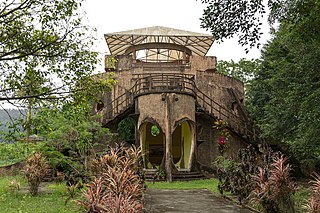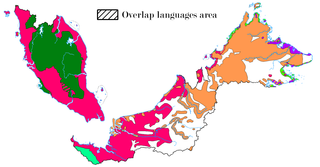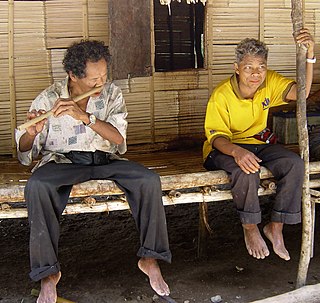
The demographics of Malaysia are represented by the multiple ethnic groups that exist in the country. Malaysia's population, according to the 2010 census, is 28,334,000 including non-citizens, which makes it the 42nd most populated country in the world. Of these, 5.72 million live in East Malaysia and 22.5 million live in Peninsular Malaysia. The population distribution is uneven, with some 79% of its citizens concentrated in Peninsular Malaysia, which has an area of 131,598 square kilometres (50,810.27 sq mi), constituting under 40% of the total area of Malaysia.

Minangkabau is an Austronesian language spoken by the Minangkabau of West Sumatra, the western part of Riau, South Aceh Regency, the northern part of Bengkulu and Jambi, also in several cities throughout Indonesia by migrated Minangkabau. The language is also a lingua franca along the western coastal region of the province of North Sumatra, and is even used in parts of Aceh, where the language is called Aneuk Jamee.

Dusun is the collective name of an indigenous ethnic group to the Malaysian state of Sabah of North Borneo. Collectively, they form the largest ethnic group in Sabah. The Dusun people have been internationally recognised as indigenous to Borneo since 2004 as per the United Nations Educational, Scientific and Cultural Organization (UNESCO)

The Kadazans are an ethnic group indigenous to the state of Sabah in Malaysia. They are found mainly in Penampang on the west coast of Sabah, the surrounding locales, and various locations in the interior.

The Ranau District is an administrative district in the Malaysian state of Sabah, part of the West Coast Division which includes the districts of Kota Belud, Kota Kinabalu, Papar, Penampang, Putatan, Ranau and Tuaran. The capital of the district is in Ranau Town. The landlocked district bordering the Sandakan Division to the east until it meets the Interior Division border. Ranau sits 108 km (67 mi) east of Kota Kinabalu and 227 km (141 mi) west of Sandakan. As of the 2010 Census, the population of the district was 94,092, an almost entirely Dusun ethnic community.
The Mangka'ak are an indigenous ethnic group residing in Sabah, eastern Malaysia on the island of Borneo. They primarily reside in the Sandakan, Labuk-Sugut, and Kinabatangan districts in northeastern Sabah. The population of Mangka'ak was estimated at 20,583 in the year 2000. They are a sub-group of the Kadazan-Dusun, and their language belongs to the Dusunic branch of the Austronesian language family. The language is threatened with extinction, as most of the current generation use standard Malay in everyday speech.

Kadazan-Dusun also less-known as "Mamasok Sabah" are two indigenous peoples of Sabah, Malaysia—the ethnic groups Kadazan and Dusun. The Kadazandusun is the largest native group of Bumiputra in Sabah. They are also known as "Mamasok", which means "originals" or "indigenous people". Most of the Kadazan-Dusun tribes believed they are descendants of Nunuk Ragang people. Kadazan-Dusun has been recognised as an indigenous nation of Borneo with documented heritage by the United Nations Educational, Scientific and Cultural Organization (UNESCO) since 2004. Kadazan-Dusun is also recognised as a bumiputera group in Sabah that has its own special rights from land rights, rivers, to maintaining customs.

Nunuk Ragang is a site traditionally considered as the location of the original home of the ancestors of the Kadazan-Dusun natives who inhabit most of northern Borneo. The site, nearby a village named Tampias, is located at the intersection of the left and right branches of the Liwagu River to the east of Ranau and Tambunan in Sabah. The two river branches joined up to flow into the Labuk river and drain out into the Sulu Sea. At the site, and under a giant banyan tree, a settlement referred to as Nunuk Ragang was founded. The giant banyan tree was said to be able to give shade to a longhouse sheltering 10 families in it. The legend about Nunuk Ragang had been passed down via oral traditions to the younger generations. No archaeological dig has been carried out to establish the veracity of the legend.
Temuan language is a Malayic language spoken by the Temuan people, one of the Orang Asli or indigenous peoples of Peninsular Malaysia which can be found in the states of Selangor, Pahang, Johor, Malacca and Negeri Sembilan. Temuan is a separate language but has a degree of mutual intelligibility with the Malay language. It is written in a Latin alphabet, but no standard orthography has been made.

The indigenous languages of Malaysia belong to the Mon-Khmer and Malayo-Polynesian families. The national, or official, language is Malay which is the mother tongue of the majority Malay ethnic group. The main ethnic groups within Malaysia are the Malay people, Han Chinese people and Tamil people, with many other ethnic groups represented in smaller numbers, each with its own languages. The largest native languages spoken in East Malaysia are the Iban, Dusunic, and Kadazan languages. English is widely understood and spoken within the urban areas of the country; the English language is a compulsory subject in primary and secondary education. It is also the main medium of instruction within most private colleges and private universities. English may take precedence over Malay in certain official contexts as provided for by the National Language Act, especially in the states of Sabah and Sarawak, where it may be the official working language. Furthermore, the law of Malaysia is commonly taught and read in English, as the unwritten laws of Malaysia continues to be partially derived from pre-1957 English common law, which is a legacy of past British colonisation of the constituents forming Malaysia. In addition, authoritative versions of constitutional law and statutory law are continuously available in both Malay and English.

Lun Bawang or Lundayeh is the language spoken by the Lun Bawangs. It belongs to the Malayo-Polynesian family.
Central Dusun, also known as Bunduliwan, is one of the more widespread languages spoken by the Dusun peoples of Sabah, Malaysia.
The Dusunic languages are a group of languages spoken by the Bisaya and Dusun, and related peoples in the Malaysian province of Sabah on Borneo.
The Greater North Borneo languages are a proposed subgroup of the Austronesian language family. The subgroup covers languages that are spoken throughout much of Borneo, as well as parts of Sumatra and Java, and Mainland Southeast Asia. The Greater North Borneo hypothesis was first proposed by Robert Blust (2010) and further elaborated by Alexander Smith. The evidence presented for this proposal are solely lexical.

The Orang Asal are the indigenous people of Malaysia. The term is Malay for "Original People", used to refer to the aboriginals of Sabah, Sarawak, and Peninsular Malaysia. These groups are given the Bumiputera status in Malaysia.
Molbog is an Austronesian language spoken in the Philippines and Sabah, Malaysia. The majority of speakers are concentrated at the southernmost tip of the Philippine province of Palawan, specifically the municipalities of Bataraza and Balabac. Both municipalities are considered as bastions for environmental conservation in the province. The majority of Molbog speakers are Muslims.
Kimaragang (Marigang), Tobilung, and Rungus are varieties of a single Austronesian language of Sabah, Malaysia. The three varieties share moderate mutual intelligibility. Children are not learning it well in some areas.

The United Pasokmomogun Kadazan Organisation was a Kadazan-Dusun-Murut (KDM) based political party in North Borneo and later Sabah at the time it became a state of Malaysia in the 1960s.

The population of Sabah stands at 3,418,785 according to the 2020 Malaysian census. This makes Sabah the third most populous state in Malaysia. It also has the highest non-citizen population at 810,443. Although Malaysia is one of the least densely populated countries in Asia, Sabah is particularly sparsely populated. Most of the population is concentrated along coastal areas, with towns and urban centers seeing the most population growth. The population of Sabah in 1970 was 653,604, with both the state and its neighbour Sarawak having about the same number of foreign nationals. In 1980, the state saw a sharp rise in its population with the arrival of almost a million refugees fleeing the Moro conflict in neighbouring southern Philippines. Around the same time, large numbers of legal workers from both Indonesia and the Philippines also arrived in Sabah, drawn by the economic boom in its primary sector. In 1992, Sabah's population increased to over 1,734,685, then to 2,468,246 in 2000. By 2010, this grew to 3,117,405. Sabah has 900,000 registered migrant workers in agriculture, plantations, construction, services, and domestic work. The total number of illegal immigrants and refugees Most of these illegal immigrants are believed to have been categorized as "other bumiputera" in the national statistics. Sabah has also seen an increase in the number of expatriates, mostly from China, Taiwan, South Korea, Japan, Australia, and Europe. In the near term, the population is expected to grow from increasing interracial marriages and migration.

The Beluran District is an administrative district in the Malaysian state of Sabah, part of the Sandakan Division which includes the districts of Beluran, Kinabatangan, Sandakan, Telupid and Tongod. The capital of the district is in Beluran Town.












